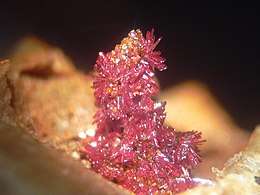Iranite
- for "Iranites" the fossil cephalopod genus see Xenodiscidae
| Iranite | |
|---|---|
 | |
| General | |
| Category | Silicate mineral |
| Formula (repeating unit) | Pb10Cu(CrO4)6(SiO4)2(F,OH)2 |
| Strunz classification | 7.FC.15 |
| Crystal system | Triclinic |
| Space group |
Triclinic pedial H-M symbol: (1) Space group: P1 |
| Unit cell | a = 10.02 Å, b = 9.54 Å, c = 9.89 Å; α = 104.5°, β = 66°, γ = 108.5°; Z=1 |
| Identification | |
| Color | Brown to orange |
| Crystal habit | Equant to flattened euhedral crystals |
| Mohs scale hardness | 3 |
| Luster | Vitreous |
| Streak | Yellow |
| Specific gravity | 5.8 |
| Optical properties | Biaxial |
| Refractive index | nα = 2.250 - 2.300 nγ = 2.400 - 2.500 |
| Birefringence | δ = 0.150 - 0.200 |
| References | [1][2][3] |
Iranite (Persian: ایرانیت) is a triclinic lead copper chromate silicate mineral with formula Pb10Cu(CrO4)6(SiO4)2(F,OH)2. It was first described from an occurrence in Iran. It is the copper analogue of hemihedrite (Pb10Zn(CrO4)6(SiO4)2(F,OH)2).[2]
It occurs as an oxidation product of hydrothermal lead-bearing veins. Associated minerals include dioptase, fornacite, wulfenite, mimetite, cerussite and diaboleite.[1] It was first described in 1970 for an occurrence in the Sebarz Mine, northeast of Anarak, Iran.[2][1]
References
This article is issued from
Wikipedia.
The text is licensed under Creative Commons - Attribution - Sharealike.
Additional terms may apply for the media files.